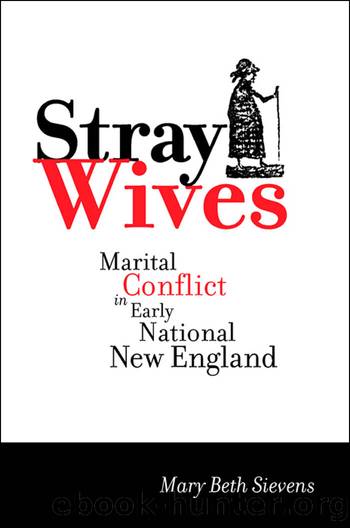Stray Wives by Mary Beth Sievens

Author:Mary Beth Sievens [Sievens, Mary Beth]
Language: eng
Format: epub
Tags: History, United States, General
ISBN: 9780814740651
Google: F5YUCgAAQBAJ
Publisher: NYU Press
Published: 2008-03-15T22:16:59+00:00
5
âHaving Confidence in Her Own Abilitiesâ
Coping with Estrangement
In the Vermont Journal of April 28, 1790, David Read accused his wife Rebecca of eloping, and he refused to pay any debts that she contracted. On May 19, Rebecca responded, claiming that âI never had thoughts of leaving him until we were advised to part, by some friends, as it was supposed we never should live agreeably together; we accordingly parted, and that mutually: he engaging to pay me a certain sum annually for my support; which however, he has not doneâbut neglects it.â David and Rebecca Read had been among the first settlers of the town of Ryegate, Vermont, arriving in 1774 and taking possession of two lots of uncleared land and two house lots. David Read was a prosperous settler and was active in civic affairs. He owned five seats in the Ryegate meeting house, served in the Vermont militia during the Revolution, and served as town constable in 1776. According to Ryegateâs 1789 Grand List, Readâs tax assessment was the tenth highest out of forty-four total taxpayers. In 1794, Read was the eighth largest landowner in town. Readâs prosperity and civic accomplishments did not make him immune to marital conflict, however. After their separation in 1790, David and Rebecca lived apart, never reconciling. When Rebecca died in 1817, probate records reveal that her estate was worth $228, just enough to pay her debts. Clothing, linens, household utensils, and a few pieces of furniture made up the modest estate. Rebecca Read owned no real estate and the records do not reveal where or with whom she had lived. When David died in 1826, his estate included a twenty-acre farm, livestock, tools, furniture, utensils, and clothing. After claims against the estate were settled and administrative costs paid, the estate was worth approximately sixteen hundred dollars.1
The records confirm that David and Rebecca Read remained permanently separated until their deaths.2 In contrast, John and Hester Smith of Burlington, Connecticut, reconciled after they separated in 1812. The couple had married in 1794; Hester had borne at least two daughters and one son by 1812, when John posted her desertion on December 22. Hester responded on January 5, claiming that she had left because âhe has frequently abused me in the most reproachful language; has frequently struck me, without provocation, with his fists and with clubs; wrung my neck; frequently turned me out of doors, and told me never to enter his doors again, and fastened the door against me.â By 1820, Hester had entered Johnâs doors again; when John died intestate in 1822, Hester received her dower share in his estate, which was worth over $750.3
Why did some couples reconcile while others remained separated? No doubt intangible factors such as personality, and emotions such as love, hurt, and anger played their parts in determining the outcomes of these conflicts. However, an examination of the lives of one hundred Vermont and seventy-five Connecticut couples who posted elopement notices between 1790 and 1830 reveals more material considerations that helped determine how couples coped with marital difficulties.
Download
This site does not store any files on its server. We only index and link to content provided by other sites. Please contact the content providers to delete copyright contents if any and email us, we'll remove relevant links or contents immediately.
The New Jim Crow: Mass Incarceration in the Age of Colorblindness by Alexander Michelle(821)
The Complete Idiot's Guide to Forensics by Alan Axelrod(806)
A New Kind of Monster: The Secret Life and Shocking True Crimes of an Officer . . . And a Murderer by Timothy Appleby(792)
HELTER SKELTER by Vincent Bugliosi(776)
Love Behind Bars by Jodie Sinclair(765)
A Life and Death Decision by Scott E. Sundby(660)
Executing Freedom by Daniel Lachance(657)
Ratman: The Trial and Conviction of Whitey Bulger by Howie Carr(648)
A Wilderness of Error: The Trials of Jeffrey MacDonald by Errol Morris(633)
The Killer of Little Shepherds: A True Crime Story and the Birth of Forensic Science by Douglas Starr(624)
Stop and Frisk by Michael D. White & Henry F. Fradella(618)
Scotland Yard Casebook by Lock Joan(606)
The Central Park Five by Sarah Burns(601)
Homicide Special: A Year With the LAPD's Elite Detective Unit by Miles Corwin(601)
Issues and Controversies in Policing Today by Johnny Nhan(582)
Kidnapped by a Client by Sharon R. Muse(579)
Until Proven Innocent by Stuart Taylor Jr(560)
How to Beat The Police Interrogation - Learn Their Dirty Tricks & Tools by Learn Their Dirty Tricks & Tools(552)
Why Some Women Lie About Rape by Linda Fairstein(505)
